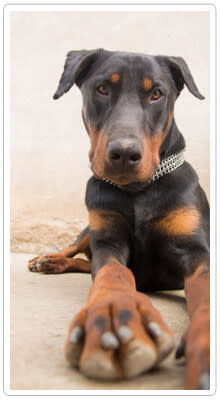
Like people, some dogs are not hardwired to relax. Sometimes, a nervous canine nature stems from genetics. Sometimes, clinical fearfulness is a result of poor socialization in puppyhood – not abuse, as so many people assume. Sometimes, severe illness can also lead to anxious behaviors in dogs.
Using dedicated and consistent behavior modification, you can help a dog learn to be calm in a variety of situations.
Even in seemingly normal dogs, I think it’s a great idea to teach your dog how to relax when asked.
Relaxation Protocol Overview
The idea of using a systematic process for teaching dogs to relax dates back to the 1970s. The version of the so-called Protocol for Relaxation most people I know use comes from veterinarian and animal behaviorist Dr. Karen Overall.
Personally, I used both Overall’s version and one given to me by the animal behaviorist from the veterinary school at Colorado State University that included household things my Border Collie found scary – such as opening a kitchen window or the microwave beeping.
In the simplest terms, you teach your dog to settle down and defer to you no matter what happens – loud noises, rapid movement, people or other dogs around and essentially anything that makes your dog nervous or rambunctious.
You’ll combine small, high-value food and calm praise as rewards when your dog remains seated during a variety of increasingly difficult distractions.
You begin with asking the dog to sit for 5 seconds. That’s it – just sit calmly for 5 seconds. Then, you build on that simple request over 15 days.
Some dogs do a lot better after those first 15 days. With other dogs, like mine, it can take many months of practicing relaxation protocol behaviors in a variety of places.
Relaxation Protocol Example
Some people encourage their dogs to lie down and remain lying down during each training session. The behaviorist I consulted wanted me instead to release my Border Collie from each task, then ask her to sit again for the next one. The repetition of asking, doing and rewarding, she felt, was important to the process of trying to rewire my dog’s brain for a relaxed response when asked.
Here, for example, are the first 10 tasks from day one of the Relaxation Protocol:
Sit for 5 seconds
Sit for 10 seconds
Sit while you take 1 step back and return
Sit while you take 2 steps back and return
Sit for 10 seconds
Sit while you take 1 step to the right and return
Sit while you take 1 step to the left and return
Sit for 10 seconds
Sit while you take 2 steps back and return
Sit while you take 2 steps to the right and return
Because I personally found the daily lists of tasks daunting and I was forever losing my place, I created MP3 audio files of each day’s tasks. I found it much easier to listen to the instructions, while training my dog. These Relaxation Protocol MP3 files are available for free download .
Canine Relaxation Tips
You’ll have to experiment and find just the right combination of food rewards, tone of voice, and body posture that works best for your dog. I used tiny pieces of cheddar cheese or meat. I spoke in a very soft voice and even turned my body a bit away from my dog, while keeping my eyes nearly closed – so that she didn’t feel any physical pressure from me during training.
Some people use a specific mat for relaxation training so that the dog associates the mat with relaxing. This is handy since you can bring the mat with you, wherever you go, and the dog then feels she has a safe space.
References
Overall KL, Protocol for Relaxation, Clinical Behavioral Medicine for Small Animals.